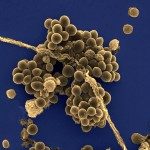Link to Pubmed [PMID] – 11111901
Int. J. Med. Microbiol. 2000 Oct;290(4-5):295-9
Bacillus thuringiensis is a spore-forming bacterium well known for its insecticidal properties and its ability to produce a crystal inclusion during sporulation. The specific activity of B. thuringiensis against insect larvae is due to the crystal proteins (Cry proteins). Two different transcriptional mechanisms (dependent and independent of sporulation) are responsible for cry gene transcription during the stationary phase. In addition to these specific insecticidal toxins, B. thuringiensis produces potential virulence factors including haemolysins, degradative enzymes and enterotoxins. A pleiotropic regulator (PlcR) that activates the transcription of various genes encoding such extracellular proteins has been identified. Its expression at the onset of the stationary phase is dependent on the growth medium and is controlled by the transition state regulator, SpoOA.

